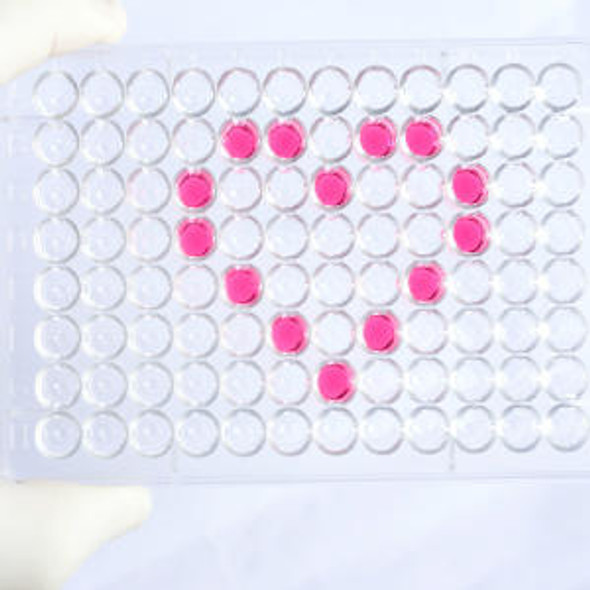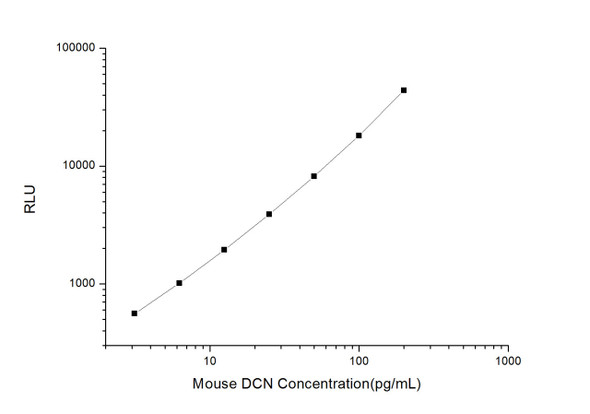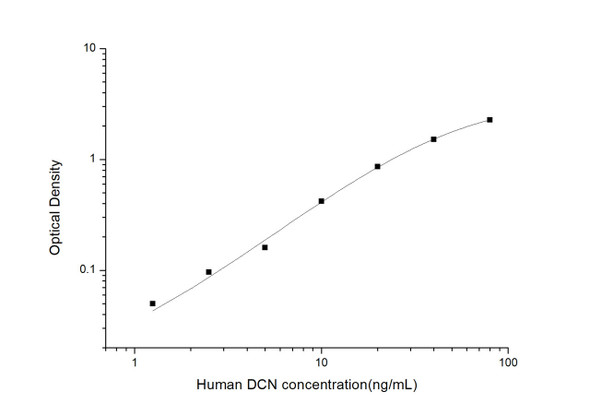Human Cell Biology ELISA Kits 5
Human DCN (Decorin) CLIA Kit (HUES01179)
- SKU:
- HUES01179
- Product Type:
- ELISA Kit
- ELISA Type:
- CLIA Kit
- Size:
- 96 Assays
- Sensitivity:
- 0.19ng/mL
- Range:
- 0.31-20ng/mL
- ELISA Type:
- Sandwich
- Reactivity:
- Human
- Sample Type:
- Serum, plasma and other biological fluids
- Research Area:
- Cell Biology
Description
| Assay type: | Sandwich |
| Format: | 96T |
| Assay time: | 4.5h |
| Reactivity: | Human |
| Detection method: | Chemiluminescence |
| Detection range: | 0.31-20 ng/mL |
| Sensitivity: | 0.19 ng/mL |
| Sample volume: | 100µL |
| Sample type: | Serum, plasma and other biological fluids |
| Repeatability: | CV < 15% |
| Specificity: | This kit recognizes Human DCN in samples. No significant cross-reactivity or interference between Human DCN and analogues was observed. |
This kit uses Sandwich-CLIA as the method. The micro CLIA plate provided in this kit has been pre-coated with an antibody specific to Human DCN. Standards or samples are added to the appropriate micro CLIA plate wells and combined with the specific antibody. Then a biotinylated detection antibody specific for Human DCN and Avidin-Horseradish Peroxidase (HRP) conjugate are added to each micro plate well successively and incubated. Free components are washed away. The substrate solution is added to each well. Only those wells that contain Human DCN, biotinylated detection antibody and Avidin-HRP conjugate will appear fluorescence. The Relative light unit (RLU) value is measured spectrophotometrically by the Chemiluminescence immunoassay analyzer. The RLU value is positively associated with the concentration of Human DCN. The concentration of Human DCN in the samples can be calculated by comparing the RLU of the samples to the standard curve.
| UniProt Protein Function: | DCN: May affect the rate of fibrils formation. Defects in DCN are the cause of congenital stromal corneal dystrophy (CSCD). Corneal dystrophies are inherited, bilateral, primary alterations of the cornea that are not associated with prior inflammation or secondary to systemic disease. Most show autosomal dominant inheritance. Belongs to the small leucine-rich proteoglycan (SLRP) family. SLRP class I subfamily. 5 isoforms of the human protein are produced by alternative splicing. |
| UniProt Protein Details: | Protein type:Secreted, signal peptide; Extracellular matrix; Secreted; Motility/polarity/chemotaxis Chromosomal Location of Human Ortholog: 12q21. 33 Cellular Component: extracellular matrix; lysosomal lumen; proteinaceous extracellular matrix; extracellular space; Golgi lumen; extracellular region; collagen type VI Molecular Function:collagen binding; glycosaminoglycan binding; extracellular matrix binding; protein N-terminus binding Biological Process: extracellular matrix organization and biogenesis; skeletal muscle development; chondroitin sulfate biosynthetic process; glycosaminoglycan metabolic process; wound healing; response to lipopolysaccharide; pathogenesis; dermatan sulfate biosynthetic process; chondroitin sulfate metabolic process; extracellular matrix disassembly; organ morphogenesis; response to mechanical stimulus; chondroitin sulfate catabolic process; carbohydrate metabolic process; kidney development; peptide cross-linking via chondroitin 4-sulfate glycosaminoglycan; aging; placenta development Disease: Corneal Dystrophy, Congenital Stromal |
| NCBI Summary: | The protein encoded by this gene is a small cellular or pericellular matrix proteoglycan that is closely related in structure to biglycan protein. The encoded protein and biglycan are thought to be the result of a gene duplication. This protein is a component of connective tissue, binds to type I collagen fibrils, and plays a role in matrix assembly. It contains one attached glycosaminoglycan chain. This protein is capable of suppressing the growth of various tumor cell lines. There are multiple alternatively spliced transcript variants known for this gene. This gene is a candidate gene for Marfan syndrome. [provided by RefSeq, Jul 2008] |
| UniProt Code: | P07585 |
| NCBI GenInfo Identifier: | 129951 |
| NCBI Gene ID: | 1634 |
| NCBI Accession: | P07585. 1 |
| UniProt Secondary Accession: | P07585,Q9P0Z0, Q9P0Z1, Q9Y5N8, Q9Y5N9, |
| UniProt Related Accession: | P07585 |
| Molecular Weight: | 8,266 Da |
| NCBI Full Name: | Decorin |
| NCBI Synonym Full Names: | decorin |
| NCBI Official Symbol: | DCN |
| NCBI Official Synonym Symbols: | CSCD; PG40; PGII; PGS2; DSPG2; SLRR1B |
| NCBI Protein Information: | decorin; PG-S2; bone proteoglycan II; decorin proteoglycan; proteoglycan core protein; small leucine-rich protein 1B; dermatan sulphate proteoglycans II |
| UniProt Protein Name: | Decorin |
| UniProt Synonym Protein Names: | Bone proteoglycan II; PG-S2; PG40 |
| Protein Family: | Decorin |
| UniProt Gene Name: | DCN |
| UniProt Entry Name: | PGS2_HUMAN |
As the RLU values of the standard curve may vary according to the conditions of the actual assay performance (e. g. operator, pipetting technique, washing technique or temperature effects), the operator should establish a standard curve for each test. Typical standard curve and data is provided below for reference only.
| Concentration (ng/mL) | RLU | Average | Corrected |
| 20 | 31570 36394 | 33982 | 33950 |
| 10 | 11672 13268 | 12470 | 12438 |
| 5 | 5632 4868 | 5250 | 5218 |
| 2.5 | 2418 2630 | 2524 | 2492 |
| 1.25 | 1397 1369 | 1383 | 1351 |
| 0.63 | 898 836 | 867 | 835 |
| 0.31 | 599 647 | 623 | 591 |
| 0 | 31 33 | 32 | -- |
Precision
Intra-assay Precision (Precision within an assay): 3 samples with low, mid range and high level Human DCN were tested 20 times on one plate, respectively.
Inter-assay Precision (Precision between assays): 3 samples with low, mid range and high level Human DCN were tested on 3 different plates, 20 replicates in each plate.
| Intra-assay Precision | Inter-assay Precision | |||||
| Sample | 1 | 2 | 3 | 1 | 2 | 3 |
| n | 20 | 20 | 20 | 20 | 20 | 20 |
| Mean (ng/mL) | 0.98 | 2.76 | 8.16 | 1.06 | 2.83 | 8.15 |
| Standard deviation | 0.08 | 0.23 | 0.75 | 0.13 | 0.26 | 0.74 |
| C V (%) | 8.16 | 8.33 | 9.19 | 12.26 | 9.19 | 9.08 |
Recovery
The recovery of Human DCN spiked at three different levels in samples throughout the range of the assay was evaluated in various matrices.
| Sample Type | Range (%) | Average Recovery (%) |
| Serum (n=5) | 100-117 | 107 |
| EDTA plasma (n=5) | 94-110 | 102 |
| Cell culture media (n=5) | 96-107 | 102 |
Linearity
Samples were spiked with high concentrations of Human DCN and diluted with Reference Standard & Sample Diluent to produce samples with values within the range of the assay.
| Serum (n=5) | EDTA plasma (n=5) | Cell culture media (n=5) | ||
| 1:2 | Range (%) | 87-101 | 102-116 | 99-111 |
| Average (%) | 93 | 108 | 105 | |
| 1:4 | Range (%) | 89-103 | 104-115 | 99-111 |
| Average (%) | 94 | 109 | 105 | |
| 1:8 | Range (%) | 87-102 | 94-109 | 91-101 |
| Average (%) | 93 | 100 | 96 | |
| 1:16 | Range (%) | 94-106 | 93-109 | 91-103 |
| Average (%) | 100 | 101 | 96 |
An unopened kit can be stored at 4°C for 1 month. If the kit is not used within 1 month, store the items separately according to the following conditions once the kit is received.
| Item | Specifications | Storage |
| Micro CLIA Plate(Dismountable) | 8 wells ×12 strips | -20°C, 6 months |
| Reference Standard | 2 vials | |
| Concentrated Biotinylated Detection Ab (100×) | 1 vial, 120 µL | |
| Concentrated HRP Conjugate (100×) | 1 vial, 120 µL | -20°C(shading light), 6 months |
| Reference Standard & Sample Diluent | 1 vial, 20 mL | 4°C, 6 months |
| Biotinylated Detection Ab Diluent | 1 vial, 14 mL | |
| HRP Conjugate Diluent | 1 vial, 14 mL | |
| Concentrated Wash Buffer (25×) | 1 vial, 30 mL | |
| Substrate Reagent A | 1 vial, 5 mL | 4°C (shading light) |
| Substrate Reagent B | 1 vial, 5 mL | 4°C (shading light) |
| Plate Sealer | 5 pieces | |
| Product Description | 1 copy | |
| Certificate of Analysis | 1 copy |
- Set standard, test sample and control (zero) wells on the pre-coated plate and record theirpositions. It is recommended to measure each standard and sample in duplicate. Note: addall solutions to the bottom of the plate wells while avoiding contact with the well walls. Ensuresolutions do not foam when adding to the wells.
- Aliquot 100 µL of standard solutions into the standard wells.
- Add 100 µL of Sample / Standard dilution buffer into the control (zero) well.
- Add 100 µL of properly diluted sample (serum, plasma, tissue homogenates and otherbiological fluids. ) into test sample wells.
- Cover the plate with the sealer provided in the kit and incubate for 90 min at 37 °C.
- Aspirate the liquid from each well, do not wash. Immediately add 100 µL of BiotinylatedDetection Ab working solution to each well. Cover the plate with a plate seal and gently mix. Incubate for 1 hour at 37 °C.
- Aspirate or decant the solution from the plate and add 350 µL of wash buffer to each welland incubate for 1-2 minutes at room temperature. Aspirate the solution from each well andclap the plate on absorbent filter paper to dry. Repeat this process 3 times. Note: a microplatewasher can be used in this step and other wash steps.
- Add 100 µL of HRP Conjugate working solution to each well. Cover with a plate seal andincubate for 30 min at 37 °C.
- Aspirate or decant the solution from each well. Repeat the wash process for five times asconducted in step 7.
- Add 100 µL of Substrate mixture solution to each well. Cover with a new plate seal andincubate for no more than 5 min at 37 °C. Protect the plate from light.
- Determine the RLU value of each well immediately.






